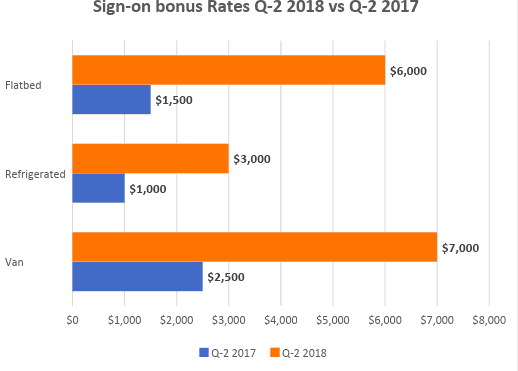While the topic of the nation’s driver squeeze remains on the table, sign-on bonuses have come under intense scrutiny. As with recent pay increases, we’ve seen a boost in bonuses offered by some of the biggest names in the game.

This graph, provided by the National Transportation Institute, depicts a hike in rates for flatbed, refrigerated, and van fleets over the course of a year (Q-2 2017 to Q-2 2018). The Washington Post’s May 28, 2018 write-up on the driver shortage tackles this topic, interviewing drivers from across the industry to tell the truth about these persuasive perks.
“Many trucking companies are so desperate for drivers that they are offering signing bonuses and pay raises,” the Post reports before delving into interviews with truck drivers from across the country. But are bonuses even effective when it comes to the driver squeeze and retention rates? As TJ Graff, director of innovation at TTJ Consulting Group, puts it: “Throwing money at a problem doesn’t solve a problem.”
Daniel Gollnick, who has driven for Roehl Transport and Melton Truck Lines, praises the job, calling it “the easiest money you can get without a college degree,” but scorns the appealing ads that make bonuses seem within arm’s reach for drivers. “I see those ads for big driver bonuses, but it’s a complete joke,” Gollnick commented, later sharing that his former companies were not transparent about what it takes “to get that $1,000.” As for the fine print? Special training in handling hazardous materials or additional certifications for driving on military bases are common clauses, as is the ability “to meet fuel-usage requirements, but they usually give you the oldest trucks that are least likely to get the sign-on bonuses because they use more fuel,” according to Gollnick.
Not all bonuses are sign-on bonuses. Earlier this year, Covenant Transport announced a $40,000 bonus for all its team drivers, which features prominently on their website and took effect in February 2018. A January 2018 press release digs into the details, noting that team drivers are eligible to earn “$2,000 in bonus money…every time a team eclipses 60,000 paid miles together. The team drivers will receive $1,000 each, up to a total combined $40,000, or $20,000 each.” This promotion is part of the plan to attract and retain team drivers, who may find themselves “underutilized” by other companies who tend to “bring on team drivers and put them on solo lanes,” according to David Parker, CEO and founder of Covenant Transport and former team driver himself.
While this sounds enticing, if you dig into the details, you might be surprised to know that it will take five years to achieve the full-value of the bonus, if you are patient enough to reach the goal. Like most headline catching bonuses in the industry, it requires drivers to jump through hoops to achieve them. A Covenant spokesperson noted that the average team driver drives 210,000 miles annually. To achieve the goal, they would need to stay in the seat for 70 months. Even more concerning is the fact that the team must stay consistent with the same partner throughout the bonus period. This is wonderful for married couples, but not ideal for teaming up.
If you think Covenant is alone in this, you would be surprised to learn that this is a consistent practice across the industry. As carriers have become more desperate for team drivers, they have put out all the stops to fill their trucks. US Xpress offers a similar program, but the bonus level is $50,000, an attempt to “one-up” it’s cross-town rival. The 25% premium over Covenant makes a bigger headline, but is still unlikely to be paid out.
Many of these bonuses -whether a sign-on bonus or otherwise – are delivered over time—spreading out benefits based on mileage or hauls completed. Celadon announced a $4,000 bonus for new drivers starting April 30, 2018. “They will receive this money in increments of $1,000 for every 25,000 miles that they complete in hauls.” FMCSA notes that Celadon drivers averaged just over 100,000 miles each in 2017, taking up to a year to fulfill the new driver bonus—that is, if they stay in the business.
In speaking with Graff by phone, he was quick to point out that sign-on bonuses, in his estimations, “are not scams.” Rather, they’re “ineffective [strategies] when it comes to driver retention and turnover.” According to Graff, “They may not entice the quality driver you’re looking for…drivers that are attracted by a sign-on bonus are most likely to jump to the next sign-on bonus” once the first one is fulfilled. It’s what Graff refers to as “hiring your own turnover.” “If sign-on bonuses were effective,” Graff concludes, “we wouldn’t be in this situation.”
Graff’s ideal fix? “Sign-on bonuses are not effective as a solution to driver shortage and driver retention. They can be a piece of the puzzle, but not as a sole solution. Predictive hiring, along with all the other pieces of the puzzle, is what’s really needed to make a carrier a carrier of choice.”
Stay up-to-date with the latest commentary and insights on FreightTech and the impact to the markets by subscribing.











